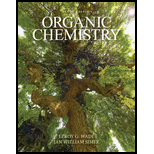
Concept explainers
The following reaction is a common synthesis used in the
When we double the concentration of methoxide ion (CH3O−), we find that the reaction rate doubles. When we triple the concentration of 1-bromobutane, we find that the reaction rate triples.
- a. What is the order of this reaction with respect to 1-bromobutane? What is the order with respect to methoxide ion? Write the rate equation for this reaction. What is the overall order?
- b. One lab textbook recommends forming the sodium methoxide in methanol solvent, but before adding 1-bromobutane, it first distills off enough methanol to reduce the mixture to half of its original volume. What difference in rate will we see when we run the reaction (using the same amounts of reagents) in half the volume of solvent?
(a)
To determine: The order of the given reaction with respect to 1-bromobutane and methoxide ion, rate equation and overall order of the reaction.
Interpretation: The order of the given reaction with respect to 1-bromobutane and methoxide ion, rate equation and overall order of the reaction is to be predicted.
Concept introduction: The order of the reaction is the sum of stoichiometric coefficients of reactants that governs the rate of the reaction. When rate of the reaction is independent to the concentration of the reactants, it called zero order reaction.
Answer to Problem 4.34SP
The order of the given reaction with respect to 1-bromobutane and methoxide ion is
Explanation of Solution
The given balanced chemical equation is,
It is given that the rate of the reaction changes when concentration of 1-bromobutane and methoxide ion is changed. This shows that the rate of the reaction depends upon the concentration of reactants.
The rate equation of the given reaction is expressed as,
Where,
The rate equation shows that the rate of reaction depends upon the concentration of 1-bromobutane and methoxide ion. The value of stoichiometric coefficient on 1-bromobutane and methoxide ion concentration term in rate equation is
The order of the reaction is the sum of stoichiometric coefficient in rate equation. Therefore, the overall order of the given reaction is
(b)
To determine: The difference in the rate, when the reaction is run in half the volume of solvent.
Interpretation: The difference in the rate, when the reaction is run in half the volume of solvent is to be predicted.
Concept introduction: The order of the reaction is the sum of stoichiometric coefficients of reactants that governs the rate of the reaction. When rate of the reaction is independent to the concentration of the reactants, it called zero order reaction.
Answer to Problem 4.34SP
The rate of the reaction would not change if the reaction is run in half the volume of solvent because the rate of the reaction depends upon the concentration of 1-bromobutane and methoxide ion.
Explanation of Solution
The rate equation of the given reaction is expressed as,
Where,
The rate equation shows that the rate of reaction depends upon the concentration of 1-bromobutane and methoxide ion. There is no effect on the rate of the reaction if concentration of solvent is changed. Therefore, the rate of the reaction would not change if the reaction is run in half the volume of solvent.
Want to see more full solutions like this?
Chapter 4 Solutions
Organic Chemistry (9th Edition)
- Can I please get help with this?arrow_forwardUse the Henderson-Hasselbalch equation to calculate pH of a buffer containing 0.050M benzoic acidand 0.150M sodium benzoate. The Ka of benzoic acid is 6.5 x 10-5arrow_forwardA. Draw the structure of each of the following alcohols. Then draw and name the product you would expect to produce by the oxidation of each. a. 4-Methyl-2-heptanol b. 3,4-Dimethyl-1-pentanol c. 4-Ethyl-2-heptanol d. 5,7-Dichloro-3-heptanolarrow_forward
- What is the pH of a 1.0 L buffer made with 0.300 mol of HF (Ka = 6.8 × 10⁻⁴) and 0.200 mol of NaF to which 0.160 mol of NaOH were added?arrow_forwardCan I please get help with this.arrow_forwardDetermine if the following salt is neutral, acidic or basic. If acidic or basic, write the appropriate equilibrium equation for the acid or base that exists when the salt is dissolved in aqueous solution. If neutral, simply write only NR. Be sure to include the proper phases for all species within the reaction. N₂H₅ClO₄arrow_forward
- Chemistry: Matter and ChangeChemistryISBN:9780078746376Author:Dinah Zike, Laurel Dingrando, Nicholas Hainen, Cheryl WistromPublisher:Glencoe/McGraw-Hill School Pub Co
 Organic And Biological ChemistryChemistryISBN:9781305081079Author:STOKER, H. Stephen (howard Stephen)Publisher:Cengage Learning,
Organic And Biological ChemistryChemistryISBN:9781305081079Author:STOKER, H. Stephen (howard Stephen)Publisher:Cengage Learning, General, Organic, and Biological ChemistryChemistryISBN:9781285853918Author:H. Stephen StokerPublisher:Cengage Learning
General, Organic, and Biological ChemistryChemistryISBN:9781285853918Author:H. Stephen StokerPublisher:Cengage Learning  ChemistryChemistryISBN:9781305957404Author:Steven S. Zumdahl, Susan A. Zumdahl, Donald J. DeCostePublisher:Cengage Learning
ChemistryChemistryISBN:9781305957404Author:Steven S. Zumdahl, Susan A. Zumdahl, Donald J. DeCostePublisher:Cengage Learning Chemistry: An Atoms First ApproachChemistryISBN:9781305079243Author:Steven S. Zumdahl, Susan A. ZumdahlPublisher:Cengage Learning
Chemistry: An Atoms First ApproachChemistryISBN:9781305079243Author:Steven S. Zumdahl, Susan A. ZumdahlPublisher:Cengage Learning





